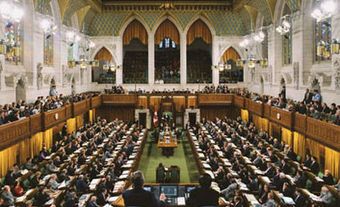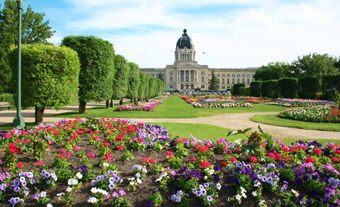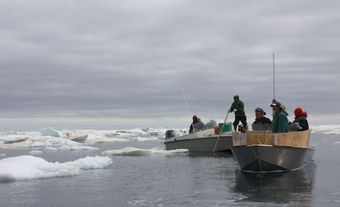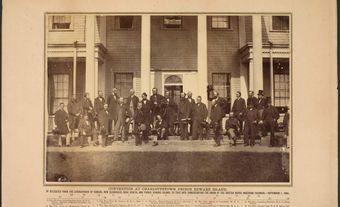Under Canada’s federal system, the powers of government are shared between the federal government, provincial governments and territorial governments. The territories — Northwest Territories, Nunavut and Yukon — are governed by their respective governments. They receive their legislative authority (the ability to create laws) from the federal government. Ottawa has given territorial governments authority over public education, health and social services; as well as the administration of justice and municipal government. More and more of these powers have been handed down from the federal government in a process called devolution. Crown-Indigenous Relations and Northern Affairs Canada is the federal ministry responsible for the territories.
What are the Differences between Provinces and Territories?
Authority to Govern
The main difference between provincial and territorial governments has to do with the separate roots of their authority to govern. According to the Constitution Act, 1867, territorial governments are under federal control. They do not have the same status as provinces. Provincial governments receive their legislative authority from the Constitution. In the territories, legislative authority is delegated (or handed down) by the federal government. This process is known as devolution.
Federal law allows the territories to form elected councils. These councils are given powers similar to provincial legislatures. The powers include authority over public education, health and social services; as well as the administration of justice and municipal government. (See also Distribution of Powers.)
Constitutional Change
Legislative powers described in the Constitution are divided between the federal government and the provinces. (See Distribution of Powers.) Changing those powers requires a constitutional amendment. (See Constitutional History; Constitutional Law.) The territories constitutionally fall under federal control. Changing the powers given to territorial governments can be achieved through an Act of Parliament. Similarly, the creation of a new province requires constitutional amendment. The creation of a new territory only requires an Act of Parliament.
Territorial governments are not included in the amending formula of the Constitution. Each territory has one seat in the House of Commons and one seat in the Senate. These representatives may vote on constitutional change. But they are not otherwise involved in the process of changing the Constitution.
The Constitution Act, 1982 gives each province the power to amend the constitution as it applies to their province. However, assent of the House of Commons and Senate is also required. Territorial constitutions are federal statutes; so only the federal Parliament can amend them.
Lands and Resources
Unlike in the provinces, Crown lands in the territories were long controlled by the federal government. Yukon and Northwest Territories gained control of their lands and resources in 2003 and 2014, respectively. Nunavut began to negotiate with Indigenous and Northern Affairs Canada (now Crown-Indigenous Relations and Northern Affairs Canada) for control over its lands and resources in October 2014.
Government Structure
The provinces are sovereign jurisdictions of the Crown in Canada. Each provincial government is headed by a lieutenant-governor. They are a representative of the Crown. It is a largely ceremonial position; the provincial equivalent of the governor general. Since the territories are under federal jurisdiction, they do not have Crown representatives. Territorial governments are instead headed by commissioners. They are appointed by the federal government, which the commissioner represents in the territory. However, the role of commissioner has become increasingly ceremonial as federal control over the territories devolves.
Each territorial government has an executive, legislative and judicial branch. But their political organization differs. Northwest Territories and Nunavut use consensus governments; they do not have political parties. Independent representatives are elected to the legislature. In turn, those representatives elect a speaker, premier and cabinet ministers from among themselves.
Yukon follows the party system. The leader of the political party with the most seats in the elected legislature becomes premier. He or she appoints a cabinet. It governs the territory with the confidence of the legislature.
Federal Transfers
Because the territories are geographically remote, they receive unconditional transfer payments from the federal government. This is known as Territorial Formula Financing (TFF). The program is similar to equalization payments, which help support public services in less prosperous provinces. TFF recognizes the higher cost of services in the North. TTF is not the only source of territorial revenue; but it does account for the majority. (See also Public Finance; Intergovernmental Finance.)
What is Devolution?
Devolution is the process by which the federal government delegates (or downloads) decision-making powers to other governments. Through devolution, territories receive the authority to create laws within their borders. This makes them more accountable to their citizens and to local interests. (See also Local Government.)
Since the mid-1970s, the federal government has devolved responsibilities to the governments of the Northwest Territories and Yukon. It has done so through the minister of Indigenous and Northern Affairs Canada (now Crown-Indigenous Relations and Northern Affairs Canada). In both territories, legislative responsibilities are now roughly the same as in the provinces, as outlined in the Constitution Act, 1867.
Northwest Territories Government
History
In 1870, the Hudson’s Bay Company sold Rupert’s Land and the North-Western Territory to Canada. This was a vast region covering present-day Alberta, Saskatchewan and Manitoba, northern Quebec and Ontario and the territories. It was known as the North-West Territories from 1870 to 1905. It was the first Canadian territory. It was governed by Ottawa through an appointed lieutenant-governor and an unelected council.
The North-West Territories Act (1875) allowed the territory to pass ordinances relating to roads; real estate; inheritance; the rights of married women; the administration of justice; and the prohibition of alcohol. However, the federal government could change or void any ordinance. The Act also outlined the creation of an elected legislative assembly and cabinet. These were introduced by 1888. The government was given responsibilities similar to those of provincial governments. However, it was not given control over its lands and resources.
By 1912, the vast lands of the North-West Territories had been divided among Yukon (1898); Alberta and Saskatchewan (1905); and Manitoba, Ontario and Quebec (1912). Given its diminished size and population, responsible government was abolished in 1905. An appointed government was restored. This lasted until 1951, when citizens were again able to elect members to council. Council became a fully elected body in 1975.
See also Northwest Territories and Confederation.

Devolution
On 1 April 2014, the Northwest Territories Devolution Act granted the Northwest Territories responsibilities similar to those held by provincial governments. This included control of Crown lands and resources. The agreement was signed by the federal government; the government of the Northwest Territories; the Inuvialuit Regional Corporation; the Northwest Territory Métis Nation (see Métis); the Sahtu Secretariat Incorporated (see Sahtu Got’ine); the Gwich’in Tribal Council (see Gwich’in); and the Tlicho Government (see Tlicho).
Consensus Government
The system of government in the Northwest Territories is called consensus government. It does not follow party politics. Instead, Members of the Legislative Assembly (MLAs) are elected as independents. There are 19 constituencies. Following an election, MLAs choose one member to serve as premier; another as speaker; and six more to serve on the Executive Council (or cabinet). The premier is responsible for assigning ministerial portfolios and leading cabinet.
MLAs who are not in cabinet become the unofficial opposition. They are regular MLAs who question government. They keep it accountable to the people. A majority of MLAs must agree to a decision, motion or legislation for it to be passed into law. Because the unofficial opposition includes 11 members, it holds the balance of power in government.
The commissioner is the federal government’s representative in the Northwest Territories. They are appointed by the minister of Crown-Indigenous Relations and Northern Affairs Canada. The position is increasingly ceremonial.

Yukon Government
History
Yukon was created by the Yukon Territory Act in 1898, at the beginning of the Klondike Gold Rush. The Act established a territorial government. It consisted of a federally appointed commissioner and council. An elected 10-member council was established in 1908. However, the gold rush had faded by that point. The population of Yukon dwindled. As a result, the council and office of the commissioner were abolished in 1918. A three-member elected council with reduced authority was established in 1919. This remained unchanged until after the Second World War. Yukon’s population then grew again.
In 1948, the role of a federally appointed commissioner was reinstated. The commissioner led an executive committee (cabinet). It included both appointed and elected members of the legislative assembly. In 1979, Yukon achieved responsible government when the role of commissioner was redefined. At that point, commissioners came to resemble provincial lieutenant-governors. Also in 1979, the head of government — the premier — was first elected.
See also Yukon and Confederation.

Devolution
The process of devolution in Yukon started in 1998, when the Yukon Devolution Protocol Accord was signed. Since then, resource management — including forestry and mining — has been devolved to the territorial government. In October 2001, the Devolution Transfer Agreement transferred responsibility over land and resources to the territory. On 1 April 2003, Yukon became the first territory to officially take control of its land and resources. This was achieved by an amendment to the Yukon Act.
Party System
Candidates for seats in the Yukon Legislative Assembly have run under a party banner since 1978. (See Canadian Party System.) The leader of the party that wins the most seats in an election becomes premier. The premier then forms cabinet. The ruling party must hold the confidence of the 19-member Legislative Assembly to continue to govern. This is especially relevant in minority government situations.

Nunavut Government
History
Since the mid-1970s, Inuit have pursued a two-track strategy of settling their outstanding Indigenous land claims and achieving self-government. In order to settle such claims in the Northwest Territories, Inuit Tapirisat of Canada, an advocacy group, proposed that a separate territory be created.
Tunngavik Federation of Nunavut (later Nunavut Tunngavik Incorporated) was established in 1982. Representing Inuit of the eastern Arctic, it aimed to negotiate a land claims agreement with the federal government. That same year, a referendum was held in Northwest Territories. It asked whether voters supported dividing the eastern and western halves of the territory. Fifty-six per cent of voters in the territory were in favour. Roughly 80 per cent of voters in eastern NWT supported the idea. In 1992, a second referendum established the boundary of what would become Nunavut.
In 1993, the federal government passed the Nunavut Land Claims Agreement Act; as well as the Nunavut Act. The Nunavut Act divided the Northwest Territories into the Northwest Territories and Nunavut. A federally appointed commission established Nunavut’s government institutions. The first territorial election was held on 15 February 1999. Nunavut was officially created on 1 April 1999.
See also Nunavut and Confederation.

Devolution
The federal government has gradually devolved responsibilities to what is now Nunavut since the 1970s. These powers have included housing; language; health; education; and social services. However, control over land and resource management in Nunavut is currently held by Crown-Indigenous Relations and Northern Affairs Canada.
In 2008, the Canadian government, the Government of Nunavut and Nunavut Tunngavik Inc. signed the Lands and Resources Devolution Negotiation Protocol. It guides devolution negotiations. Formal negotiations for control over lands and resources started in October 2014, when an Agreement- in-Principle was signed. A chief negotiator was appointed in July 2016. Negotiations are ongoing.
Consensus Government
The Legislative Assembly of Nunavut is organized as a consensus government. This is considered to be in keeping with traditional Inuit decision-making. Members of the Legislative Assembly (MLAs) are elected as independents in 22 constituencies. Following an election, MLAs elect a premier, speaker and cabinet ministers by secret ballot. The premier is responsible for assigning ministerial portfolios and leading cabinet government. The number of seats in cabinet is not fixed; but it must not represent a majority of MLAs. MLAs who are not in cabinet (regular MLAs) hold the balance of seats. A majority of MLAs must agree to a decision, motion or legislation for it to be passed into law. Cabinet must maintain the majority support (or confidence) of the members of the legislative assembly to govern.
The commissioner is the federal government’s representative in Nunavut. The position is largely symbolic. It is appointed by the minister of Crown-Indigenous Relations and Northern Affairs Canada.
Indigenous Governance
A crucial issue in territorial governance is how to achieve the best relationship between the territorial government, as a public government, and re-emerging Indigenous governments. (See Indigenous Peoples in Canada; Indigenous Self-Government in Canada.) The major changes are different in Yukon, Nunavut and the Northwest Territories.
Indigenous communities in the Northwest Territories have negotiated self-government claims with the territorial and federal governments since the 1970s. In 1984, the Inuvialuit of the Mackenzie River delta signed the Western Arctic Claim (or the Inuvialuit Final Agreement). This gave the Inuvialuit limited self-government. In 1993, the sahtu Dene and Métis of the Northwest Territories reached a comprehensive land claims agreement with the federal government. (See also Sahtu Got’ine; Métis.)
In 1999, Nunavut, meaning “our land” in Inuktitut, was separated from the Northwest Territories. At about 2 million km2 in size, Nunavut represents the largest Indigenous land claim settlement in Canadian history. It is one fifth of Canada’s land mass. Inuit represent about 85 per cent of the population in Nunavut. They have majority representation in territorial government. This helps to ensure that government decisions reflect Inuit culture and tradition.

In Yukon, the territorial government has been adapting to a new relationship with Indigenous peoples within the territory. Indigenous communities in what is now Yukon never signed treaties with the federal government. In 1993, Canada concluded the Umbrella Final Agreement to settle the Indigenous claims in the Yukon. (See Indigenous Land Claims). The Indigenous population is dispersed among 14 recognized First Nations communities. Each of these negotiates its own final claims agreement and a self-government agreement with the governments of Canada and Yukon. As of 2020, 11 First Nations communities in Yukon had finalized agreements.
First Nations governments in Yukon share some responsibilities with the territorial government; or operate parallel to it. They offer education, language, health and social services to their members. The territorial government serves the non-Indigenous population. Each nation is responsible for law-making, land-use, fish and wildlife, forestry, water and resources.
See also Constitutional Monarchy; Federalism in Canada; Federal-Provincial Relations; Members of Provincial and Territorial Legislatures; Natural Resources in the Territories; Council of the Federation (Canada’s Premiers); Local Government.

 Share on Facebook
Share on Facebook Share on X
Share on X Share by Email
Share by Email Share on Google Classroom
Share on Google Classroom








